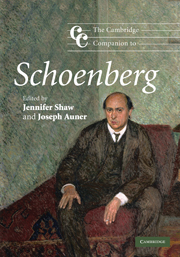Book contents
- Frontmatter
- 1 Introduction
- Part I Schoenberg's early years
- Part II Schoenberg, modernism, and modernity
- 6 Interpreting Erwartung: collaborative process and early reception
- 7 The rise and fall of radical athematicism
- 8 Schoenberg, modernism, and metaphysics
- 9 Pierrot lunaire: persona, voice, and the fabric of allusion
- Part III Schoenberg between the World Wars
- Part IV Schoenberg's American years
- Notes
- Select bibliography
- Index
8 - Schoenberg, modernism, and metaphysics
from Part II - Schoenberg, modernism, and modernity
Published online by Cambridge University Press: 28 September 2011
- Frontmatter
- 1 Introduction
- Part I Schoenberg's early years
- Part II Schoenberg, modernism, and modernity
- 6 Interpreting Erwartung: collaborative process and early reception
- 7 The rise and fall of radical athematicism
- 8 Schoenberg, modernism, and metaphysics
- 9 Pierrot lunaire: persona, voice, and the fabric of allusion
- Part III Schoenberg between the World Wars
- Part IV Schoenberg's American years
- Notes
- Select bibliography
- Index
Summary
Metaphysics
Herzgewächse, Op. 20 (Heart's Foliage) has to be one of the most extraordinary works in Schoenberg's extraordinary output. Only thirty measures long and lasting little over three minutes in performance, it is the most diminutive of all the works to which Schoenberg gave an individual opus number. Composed in just a few days in 1911 (December 5–9), the score was reproduced in facsimile in the 1912 almanac of Der Blaue Reiter, though there is no record of a performance before 1923. Scored for an ensemble of soprano, celesta, harmonium, and harp, its setting of a short poem by Maurice Maeterlinck (translated by Stefan George), requires a voice of extreme agility which is frequently taken above a high c’' and which, four bars before the end, climaxes (pppp) on a high f’'.
The poem constructs a melancholic and languorous world through the imagery of tangled plant forms. Only the pale and fragile lily reaches upwards with its “mystical white prayer.” Sensuous, erotic, and spiritual at the same time, Maeterlinck's poem recalls Wagner's “Im Treibhaus,” the third of the Wesendonck-lieder and thus part of the sketching process for Tristan und Isolde. Both songs use the claustrophobic imagery of winding foliage as a metaphor for spiritual malaise, but also to express an intense longing for release – a metaphor the matized in Schoenberg's Das Buch der Hängenden Gärten, Op. 15 (The Book of the Hanging Gardens), to texts by Stefan George, completed in March 1909.
- Type
- Chapter
- Information
- The Cambridge Companion to Schoenberg , pp. 108 - 119Publisher: Cambridge University PressPrint publication year: 2010
- 2
- Cited by

